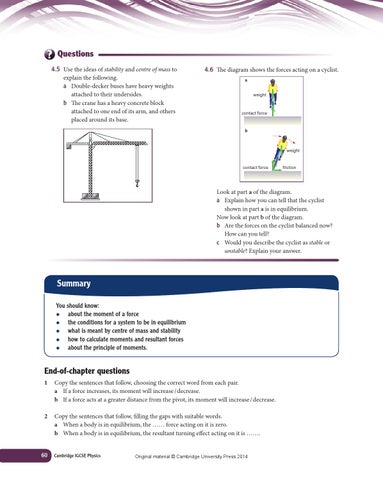Questions 4.5 Use the ideas of stability and centre of mass to explain the following. a Double-decker buses have heavy weights attached to their undersides. b The crane has a heavy concrete block attached to one end of its arm, and others placed around its base.
4.6 The diagram shows the forces acting on a cyclist. a
weight
contact force
b
weight
contact force
friction
Look at part a of the diagram. a Explain how you can tell that the cyclist shown in part a is in equilibrium. Now look at part b of the diagram. b Are the forces on the cyclist balanced now? How can you tell? c Would you describe the cyclist as stable or unstable? Explain your answer.
Summary You should know: ◆ about the moment of a force ◆ the conditions for a system to be in equilibrium ◆ what is meant by centre of mass and stability ◆ how to calculate moments and resultant forces ◆ about the principle of moments.
End-of-chapter questions 1
Copy the sentences that follow, choosing the correct word from each pair. a If a force increases, its moment will increase / decrease. b If a force acts at a greater distance from the pivot, its moment will increase / decrease.
2
Copy the sentences that follow, filling the gaps with suitable words. a When a body is in equilibrium, the …… force acting on it is zero. b When a body is in equilibrium, the resultant turning effect acting on it is …….
60
Cambridge IGCSE Physics
Original material © Cambridge University Press 2014
